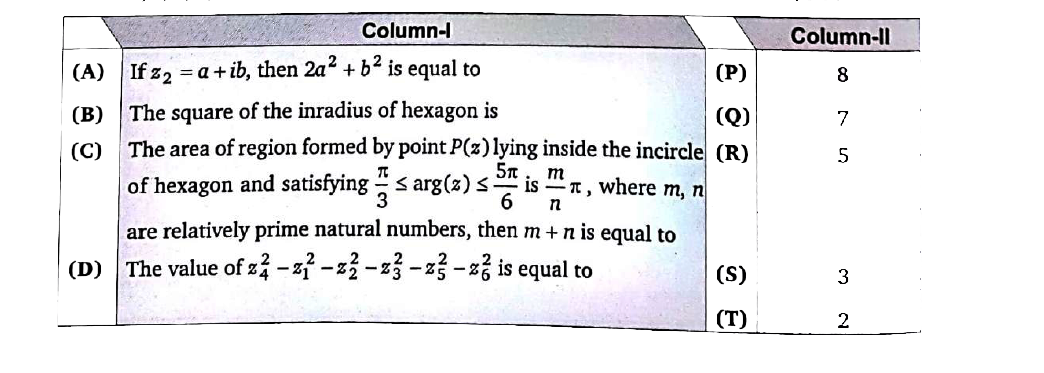Let ABCDEF is a regular hexagon A(z1),B(z2),C(z3),D(z4),E(z5),F(z6) in argand plane where A,B,C,D,E and F are taken in anticlockwise manner. If z1=−2,z3=1−√3i.

The correct Answer is:A-R, B-S, C-Q,D-P
Step by step video & image solution for Let ABCDEF is a regular hexagon A(z_1),B(z_2),C(z_3),D(z_4),E(z_5), F(z_6) in argand plane where A,B,C,D,E and F are taken in anticlockwise manner. If z_1=-2, z_3=1-sqrt3i. by Maths experts to help you in doubts & scoring excellent marks in Class 12 exams.
Updated on:21/07/2023Topper's Solved these Questions
- COMPLEX NUMBERSBOOK - VK JAISWAL ENGLISHCHAPTER - COMPLEX NUMBERSEXERCISE - EXERCISE-5 : SUBJECTIVE TYPE PROBLEMS
8 Videos
- COMPLEX NUMBERSBOOK - VK JAISWAL ENGLISHCHAPTER - COMPLEX NUMBERSEXERCISE - EXERCISE-3:COMPREHENSION TYPE PROBLEMS
8 Videos
- CIRCLEBOOK - VK JAISWAL ENGLISHCHAPTER - CIRCLEEXERCISE - Exercise - 5 : Subjective Type Problems
12 Videos
- COMPOUND ANGLESBOOK - VK JAISWAL ENGLISHCHAPTER - COMPOUND ANGLESEXERCISE - Exercise-5 : Subjective Type Problems
31 Videos
Similar Questions
The vertices of a square are z1,z2,z3andz4 taken in the anticlockwise order, then z3=
View Solutionif A(z1),B(z2),C(z3),D(z4) lies on |z|=4 (taken in order) , where z1+z2+z3+z4=0 then :
View SolutionA(z1),B(z2),C(z3) are the vertices of he triangle ABC (in anticlockwise). If ∠ABC=π/4 and AB=√2(BC) , then prove that z2=z3+i(z1−z3).
View SolutionA(z1),B(z2),C(z3) are the vertices of the triangle ABC (in anticlockwise). If ∠ABC=π/4 and AB=√2(BC) , then prove that z2=z3+i(z1−z3).
View SolutionLet A(z1),B(z2),C(z3) be the vertices of an equilateral triangle ABC in the Argand plane, then the number z2−z32z1−z2−z3, is
View SolutionLet A(z1),B(z2),C(z3 and D(z4) be the vertices of a trepezium in an Argand plane such that AB∣∣CD Let |z1−z2|=4,|z3,z4|=10 and the diagonals AC and BD intersects at P. It is given that Arg(z4−z2z3−z1)=π2 and Arg(z3−z2z4−z1)=π4
Which of the following option(s) is/are correct?
View SolutionLet A(z1),B(z2),C(z3 and D(z4) be the vertices of a trepezium in an Argand plane such that AB∣∣CD Let |z1−z2|=4,|z3,z4|=10 and the diagonals AC and BD intersects at P. It is given that Arg(z4−z2z3−z1)=π2 and Arg(z3−z2z4−z1)=π4
Which of the following option(s) is/are incorrect?
View Solution, a point 'z' is equidistant from three distinct points z1,z2 and z3 in the Argand plane. If z,z1 and z2 are collinear, then arg(zz3−z1z3−z2).Willbe(z_(1),z_(2),z_(3)) are in anticlockwise sense).
View SolutionIf |z|=2andz1−z3z2−z3=z−2z+2 , then prove that z1,z2,z3 are vertices of a right angled triangle.
View SolutionIf A(z1),B(z2)andC(z3) are three points in the argand plane where |z1+z2|=||z1−z2|and|(1−i)z1+iz3|=|z1|+|z3|−z1|, where i=√−1 then
View Solution
